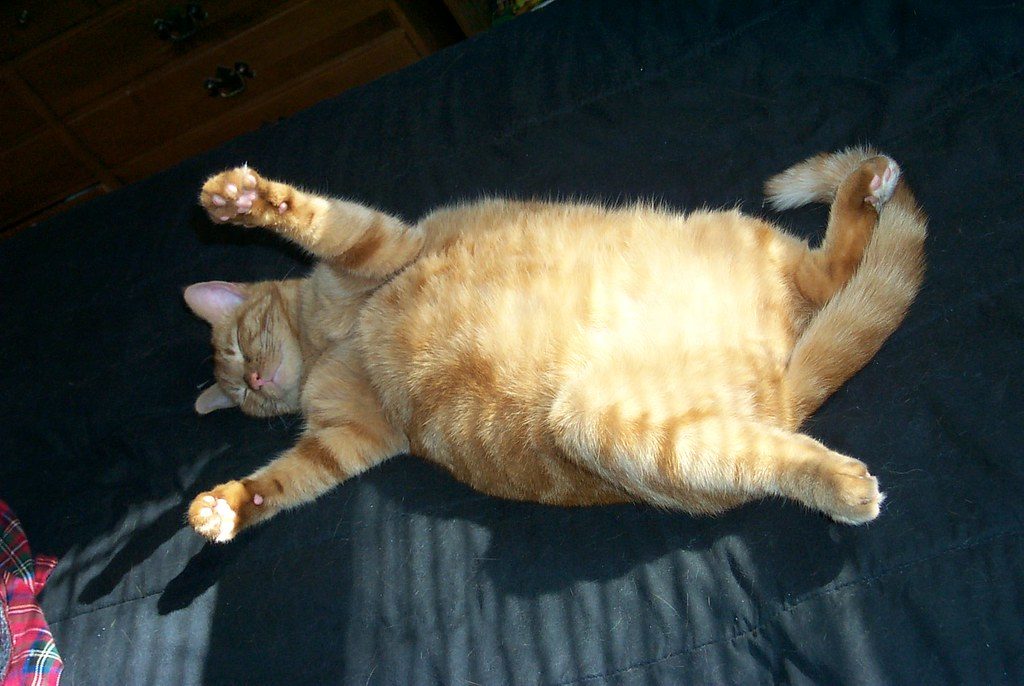Is your tabby getting thick in the midsection? Are chewing and swallowing her only exercises? If so, you may be wondering how to liven up her day, help her burn calories and improve her overall health.
A cat’s sedentary lifestyle can often result in obesity, a condition which can lead to hip, back, shoulder or knee injuries, cancer, diabetes, heart disease, and heat stroke. Clearly, being overweight can be as detrimental to your cat as it is to you.
Apart from limiting your cat’s food intake, what else can you do to combat this problem? The answer is a simple one: kick your cat’s activity level up a notch by having her exercise on a daily basis.
How To Get a Cat to Lose Weight:
Exercise? A cat? Sure. But not in the same way you might a dog. Your cat is a more independent creature, and must be motivated in different ways if she is to raise her level of activity.
Food is an effective motivator for teaching new behavior to a cat. Small treats can be used to get her moving. To raise your cat’s food drive, put her on a regular feeding schedule instead of free feeding (or leaving food down all day). Doing so will program your cat to be hungry at specific times, a key in teaching her any new behavior.
So you’ve put your cat on a regular feeding schedule, and she’s famished at dinner time. What next? Put her hunger to work. The following are ways to get your cat moving prior to dinner time:
Stair Climbing
Get your cat to climb a flight or more of stairs several times each week by sporadically relocating her food dish. Place her meal at the top or bottom of a flight of stairs, depending on your home’s layout. To get to it, she must climb or descend. If she has trouble locating her dish, try moving it up just a few steps at first, eventually placing it as far away as possible.
Random Placement of Treats
Leave small treats in various locations around the home, to condition her to explore more. Put one atop the fridge, one beneath the sofa, and another beside your television. Eventually, searching will become a regular calorie-burning activity for her.
The Recall, or ‘Come’
Have you ever owned a cat who would rush to the kitchen upon hearing the whir of an electric can opener? Without knowing it, your cat had learned to come on cue. To teach your cat to Come, try this: Buy a child’s “clicker” toy. Next, with her close by, place her dinner down immediately after clicking the toy several times. Do this at each meal for two weeks. Then, with the cat in another room, try clicking the toy several times. The cat, now conditioned to think food is coming, should come running. When the cat comes, give her a treat. Having her come on command will get her running whenever you want, in hopes of getting food. This of course burns calories.
These next activities use motivators besides food to get your cat moving:
 Playing With Toys
Playing With Toys
Cats love to chase moving objects. You can get your cat moving by enticing her with various toys, including:
- Teaser wands
- Mouse toys
- Balled-up newspaper
- Wind-up toys
- Toys suspended from a string
- Balls
- Feathers
The object is to keep your cat moving for at least 10 minutes. Have these sessions several times each day, for best results.
Companionship
A great way to keep a cat active during the day is to provide her with company. A willing partner will encourage play, and stimulate her mind. Accordingly, it’s a great idea to adopt two kittens instead of one. They will romp and chase each other, keeping activity levels high.
Walk Your Cat
Your cat can learn to walk on a leash and harness, if you start her out early. It’s a good way to get her outside without subjecting her to the dangers of cars, cat fights, or infectious diseases, contracted through physical contact with other cats. Teaching an adult cat to walk can be difficult, however, so don’t try this with a cat over 4 or 5 months of age unless she is extremely outgoing and confident.
Purchase a cat harness. Make sure to get the right size harness for your cat’s weight.
Place the harness on the cat, while rewarding her with small treats. Slowly increase the time the harness is on until she can wear it without worry or discomfort.
Then, clip a light leash to the harness. Let your cat walk around for a few minutes, dragging the leash. Then, pick up the end of it and follow her around the home. Let her guide you, and periodically reward her with a treat.
Next, take the cat out to a quiet yard, and let her explore while on leash. Do so for a few minutes, then go back inside. Each day, increase the duration of the walk, to a maximum of 10 minutes. Never take the pet into a busy environment such as a city street. The goal is to simply get her outside in a safe, controlled fashion.
This exercise is not for all cats. If your cat is young, outgoing, and well adjusted, however, a daily walk around the yard will be an enriching, calorie-burning experience.
Additional Resource
To find out more information about what type of food you should feed your cat and other useful cat information, visit the pet town.


 Playing With Toys
Playing With Toys